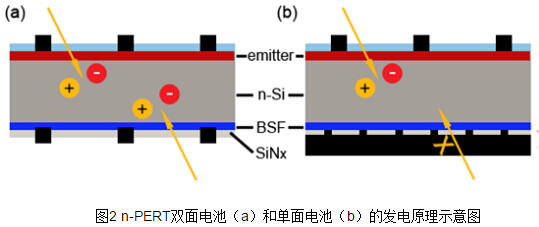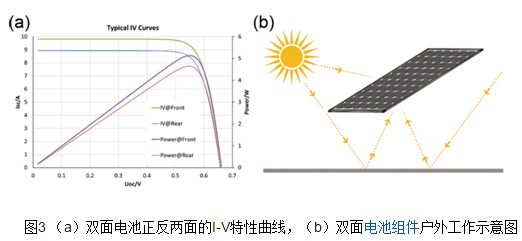A crystalline silicon solar cell is actually a large planar diode. For an n-type cell, the substrate of the cell is n-Si. The front surface of the substrate is heavily doped with diffusion to form the p+ emitter, the p+ emitter and the n-Si matrix. The contact forms a p+-n junction, and the back surface of the substrate is heavily doped by diffusion or ion implantation to form an n+ back field, and the n+ back field is in contact with the n-Si substrate to form an n+-n high and low junction. There are built-in electric fields inside the p+-n junction and the n+-n junctions. The electron-hole pairs generated by the light can be separated. The separated electrons pass through the back electrode above the back field, and the holes pass through the front electrode above the emitter. To the outside circuit, drive the load to run.

As shown in Fig. 1(a), the structure of the n-PERT double-sided battery is: metal electrode, front surface anti-reflection film, boron-doped emitter, n-type silicon, phosphorus doped back-field (BSF), back-side anti-reflection Membrane and back electrode. Compared with single-sided batteries, n-PERT double-sided battery mainly differs in the structure of the back side. The back side of the double-sided battery uses high-transmittance SiNx as passivation/anti-reflection film, and the back metal electrode is the same as the front metal electrode, and occupies the battery. The area of ​​~3%; while the single-sided battery back electrode with full metal coverage, as shown in Figure 1 (b) below.

Figure 2 shows the principle of power generation for double-sided and single-sided batteries. As shown in the figure, when the sun shines on the n-PERT double-sided battery, part of the light is reflected by the surrounding environment to the back of the n-PERT double-sided battery. This part of the light can be absorbed by the SiNx material and absorbed by the silicon. The excited electron-hole pair is separated by n+-n high and low junctions, thus contributing to the photocurrent and efficiency of the cell (Figure a). However, the back side of a single-sided battery is completely covered with a metal electrode. The thickness of the metal electrode is ~10 μm, and light cannot penetrate the back metal electrode and is absorbed by silicon. Therefore, a single-sided battery can hardly utilize light from the back side and enters the battery. When the back surface reflectance is not zero, the double-sided battery has higher power generation efficiency than the single-sided battery.

Figure 3(a) shows the IV characteristics of both sides of the double-sided battery. It can be seen that under the condition of STC, the front power of the n-PERT double-sided battery can reach 5.2 W, and the back power can reach 4.7 W. The rate is 90%. The efficiency gain of n-PERT double-sided batteries relative to single-sided batteries is difficult to measure by a single battery. Generally, multiple solar cells are connected in series or in parallel to connect the electrodes. The materials are encapsulated with materials such as EVA, glass, and backplane. , Become a component to measure the gain of efficiency. The front side of the double-sided battery pack is packaged in glass + EVA, and the back side can be packaged in an EVA+ glass package or an EVA+ transparent back plate to ensure that sunlight can shine through the package material to the back of the battery, as shown in Figure 3(b) .

When the orientation, tilt, and height of the double glass unit are fixed, the power generation gain of the double glass unit is mainly related to the reflectance of the ground on the back of the unit. Take a double glass unit as shown in Table 1 as an example. The components are different. The theoretical calculation of maximum power and maximum current in the case of back reflection is shown in Figure 4(a). As can be seen from 4(a), the maximum output power and the maximum current value of the module are positively correlated with the reflectance on the back surface, and increase with the increase of the back surface reflectance; furthermore, the maximum output power curve and the maximum current curve are similar in growth trend. This shows that the increase in the power of the module is mainly due to the increase in the current of the module, and the increase in the current of the module is due to the increase in the reflectance of the back surface so that more light is absorbed and utilized.

In addition to the advantages of using double-battery components made from mid-plane double-sided batteries that can use backscattered/reflected light to generate power and have greater power output, they also have the following advantages: Dual-glass components are installed in concrete with the ground in actual operation. Compared to polycrystalline modules, the efficiency gains for different grounds are shown in Figure 4(b). From 4(b), it can be seen that both on cloudy and sunny days, double-glass modules have the greatest gains in power generation on the white painted surface, followed by aluminum foil, and the lowest on the lawn, and are all higher than single-sided polycrystalline components. Therefore, both the theory and the practical use of the two sides have shown that the back of the double-sided battery can generate electricity, which has the effect of increasing the output power of the module.
1) The operating temperature is lower than the conventional components; the back of the battery is highly transparent SiNx material, the infrared part of the light can penetrate the battery, is not absorbed by the battery, while the back of the conventional battery is a full metal electrode, will absorb infrared light, data It is shown that the temperature of the dual glass module power generation system is 5 to 9°C lower than that of the conventional single glass module. 2) The temperature coefficient is lower than that of conventional components; when the operating temperature of the module rises by 1°C from the standard temperature, its output power will decrease by 0.42%. Under the same temperature rise condition, the power loss of the N-type module is smaller than that of the conventional P-type module, and the power loss is 0.4% or less. 3) Excellent low-light response; due to the high minority carrier lifetime of the N-type base material, the N-type crystalline silicon module exhibits superior power generation characteristics compared to the conventional P-type crystalline silicon module under low light. 4) The installation method is flexible and has a wide range of applications; it is particularly applicable to distributed power generation systems such as roofs, fences, complementary fish and light, agricultural light, and soundproof walls, and snow accumulation areas.
SHINE Steel Round Base Insert Magnets have revolutionized the precast industry. Our magnets offers long term reliability and cost effective solutions for the precast industry. Our products are durable and they last for years under all conditions. With our unique combination of rubber and integrated magnets, you can make almost any shape. Once it´s in place, it stays put. No slipping, no sliding.
The Steel Round Base Insert Magnets are used in the precast concrete production structures to form free spaces in the work-pieces to fix the concrete inserts. Insert magnets are used in Magnetic Shuttering System. This equipment type has considerably simplified some production task for the concrete structures producers. It easily gets fixed in the magnet formwork system or on the steel table due to its magnetic properties.
For fastening various parts and forming empty space in the process of reinforced concrete products manufacturing, we offer various types of magnetic holders, insert magnets and spacers, both standard and custom-made according to customer drawings.
Steel Round Base Insert Magnets
Precast Insert Magnet,Precast Concrete Insert Magnet,Steel Round Base Insert Magnets,Precast Neodymium Bushing Magnets
Ningbo Shine Magnetic Technology Co., Ltd. , https://www.shutteringmagnetic.com